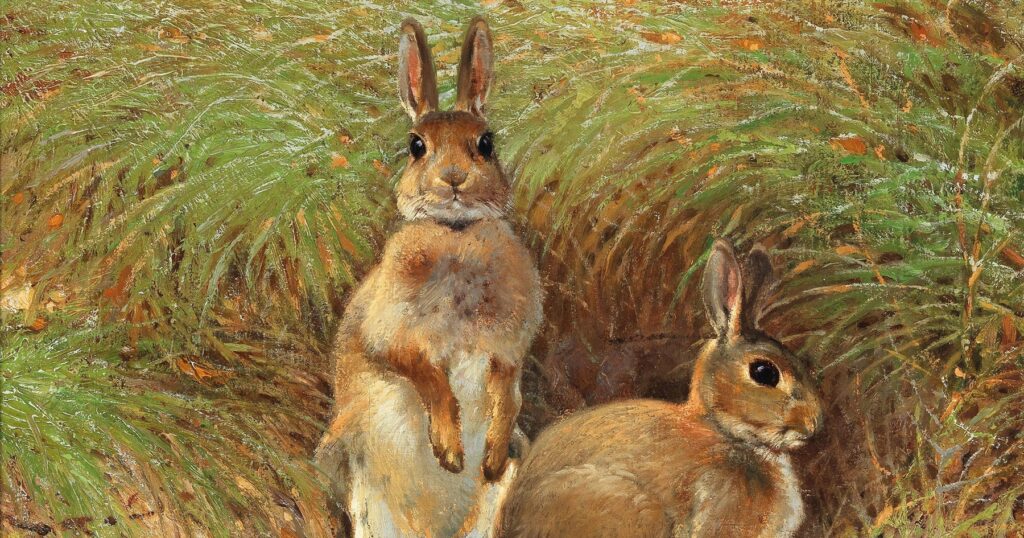A literary reflection by Caitlin Magness on Richard Adams's "Watership Down." This is one installment of a monthly series providing reflections on works of literature from a Lutheran perspective.
“All the world will be your enemy, Prince with a Thousand Enemies, and whenever they catch you, they will kill you. But first they must catch you, digger, listener, runner, prince with the swift warning. Be cunning and full of tricks and your people shall never be destroyed.” —Richard Adams, Watership Down
For most readers, the term “epic fantasy” will invoke images of fair ladies and fearsome dragons, heroic adventures and lengthy, sweeping narratives of good versus evil. While some may dismiss such stories as cartoonish or childish, irrelevant to the concerns of the real world, fantasy literature retains its power. There is a reason that epic fantasy can be considered one of the world’s oldest genres, dating back to Beowulf, one of the first works of literature in the English language. A double-edged sword, fantasy both expands our imaginations and draws us deeper into reality, cutting away the chaff to get to the heart of human experience. We are drawn to the image of the knight in shining armor because it’s fun to fantasize about slaying a dragon, and because we have our own dragons to slay.
My favorite work of epic fantasy features no dragons in the literal sense. There are no wizards, hobbits or trolls. In fact, the story takes place in a world that readers will recognize, especially those who have been to the English countryside. The heroes are a group of young men who leave their doomed hometown after they are warned about a coming catastrophe by one of their own, a prophet whose warnings go unheeded by the local government. Their journey is fraught with peril and death, for they are members of a cursed tribe, condemned by God to be constantly pursued by a “thousand enemies” as punishment for their ancestor’s hubris. These enemies come in many forms: dogs, cats, hawks, snakes, badgers, stoats and above all, man. This is the premise of Watership Down, the greatest novel ever written about talking rabbits.
Watership Down, written by 20th-century English novelist Richard Adams, opens when the main character Hazel, an ordinary and sensible rabbit, hears of a disturbing vision received by his younger brother Fiver. Fiver, a small and nervous rabbit with a gift for prophecy, foresees the total destruction of the warren, the rabbits’ home. Terrified by the vision, Fiver insists that the rabbits must leave their home immediately if they wish to survive. Despite the dismissal of the warren’s rulers and the danger of leaving their home, Hazel trusts his brother’s instincts. They are joined by a small band of others from the warren who also believe in Fiver’s prophetic abilities. Led by a reluctant Hazel, they set out on a long, perilous journey in search of a new home, leaving behind the only world they’ve ever known.
The world of Watership Down may seem strange to readers who aren’t used to animal fantasy, the subgenre of fantasy that deals in stories about talking animals. These stories tend to differ from children’s books with anthropomorphic characters, or from folklore and fairy tales involving animals, in that the existence of talking animals is not just a storytelling device, but rather something established within the world of the story. This is especially the case in Watership Down; at no point is the reader allowed to forget that the characters are rabbits. Richard Adams put an impressive amount of thought into how a society of rabbits might work. The characters live in constant fear of predators and death; their language is mostly concerned with eating and other bodily functions; they cannot count past four. Any number higher than four is simply hrair, which can be translated as “five” or “thousand.”
Some readers may find this vision of another world fascinating, while others may find it difficult to relate to characters who are so different from humans. If readers can suspend their disbelief enough to immerse themselves in the story, however, they will find that these characters are much more human than they appear. As is the case in all fantasy literature, the world of Watership Down serves as a mirror to our own world. For all that the characters differ from humans, it is those differences that bring aspects of human experience into sharper focus. We may not live in fear of dogs and hawks, but we have our own anxieties that hound our steps. These are the “cares of the world” that Jesus speaks about in Mark 4:19 that can distract us from God and choke out His Word in our hearts.
In addition to the cares and worries of daily life, we may also be troubled, like Solomon in the book of Ecclesiastes, when we are reminded the vanity of human efforts and the inevitability of death. Hazel and his companions lack the temporary security afforded by human civilization, so they are even more keenly aware of death than we are, as they struggle every day for survival against the forces of nature. But while we may forget it more easily, death stalks us just as closely. Without Christ who gives us life, we are subject to both the physical end of life and the spiritual death that prevents us from reaching our final home. “For the wages of sin is death, but the free gift of God is eternal life in Christ Jesus our Lord” (Rom. 6:23). Sin condemns us to death and separates us from God, but Christ restores us to new life in Him.
As a Christian, Richard Adams follows in the footsteps of other fantasy authors such as Tolkien and Lewis, telling a story that is not overtly Christian but nonetheless reflects Christian truths. Death and fear are not the only themes in Watership Down that the Christian reader may view in light of his or her faith. Hazel’s quest traces the familiar arc of the hero’s journey (a term coined by Joseph Campbell in his famous book The Hero with a Thousand Faces, but a story that has existed for much longer), which itself reflects the story of Christ. There is a hero from humble beginnings; there is a prophecy, a call, a journey through the wilderness. There is temptation and testing. There is a laying down of one’s life, followed by a sort of resurrection. In the end, the hero is fundamentally changed, to be received into a different kind of life than the one he had before. The Black Rabbit, the rabbits’ personification of death, comes to visit Hazel at the end of the novel. Hazel does not recognize him at first, but then he sees the rabbit’s ears glowing faintly, and his eyes are opened. “Yes, my lord, I know you,” he says, and the Black Rabbit escorts him from this life, promising that Hazel’s people will continue to prosper. Death gives way to new life: “O death, where is your victory? O death, where is your sting?” (1 Cor. 15:55).
Readers may also see in Watership Down a reflection of the Christian doctrine of vocation. Though their lives are shaped by fear and hardship and the specter of death looming over them, the rabbits do not fixate on those things in their everyday lives. It is evident that Richard Adams admires the ability of animals to truly “live in the moment,” since unlike humans who can imagine far into the future, the moment is all they have. Hazel and his companions struggle furiously to survive, not because they are overly afraid of death, but because they wish to continue living. They know that death is inevitable and that they should, therefore, make the most of their lives. After the death of one of the rabbits, the narrative notes that the survivors honor the dead in part by moving on with their own lives: “Would that the dead were not dead! But there is grass that must be eaten, pellets that must be chewed, hraka [excrement] that must be passed, holes that must be dug, sleep that must be slept. Odysseus brings not one man to shore with him. Yet he sleeps sound beside Calypso and when he wakes thinks only of Penelope.”
Solomon speaks of this peace that comes from living out one’s vocation in Ecclesiastes: “I know that there is nothing better for them than to rejoice and do good while they live, and also that every man should eat and drink and find satisfaction in all his labor—this is the gift of God” (Eccl. 3:12–13). How much easier is this to do when we also have the peace of knowing that our lives have been redeemed by Christ!
Richard Adams passed away in 2016. He wrote other novels, but there is a reason that Watership Down remains his most well-known and beloved work. Like other great stories, it speaks to universal themes — life and death, love and grief, good and evil — despite the peculiarity of its premise. It is a story that almost any reader can relate to in some way and find something of value within. (It is worth noting that, despite common assumptions about books about talking animals, Watership Down will likely be both too difficult and too dark for younger readers.) Through this tale of intrepid rabbits, we may be drawn a little deeper into what it means to be human — and, for the Christian reader, the joy and peace of life in Christ.
Cover image: “Rabbits,” by Victor Stoetzner-Lund, 1925.





